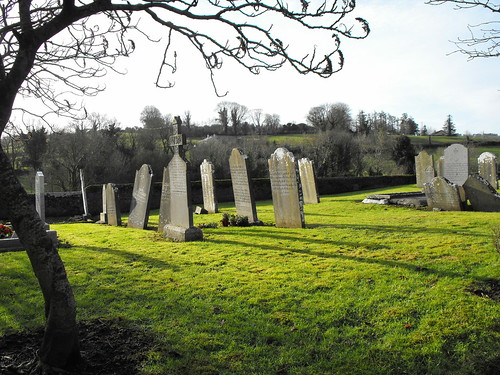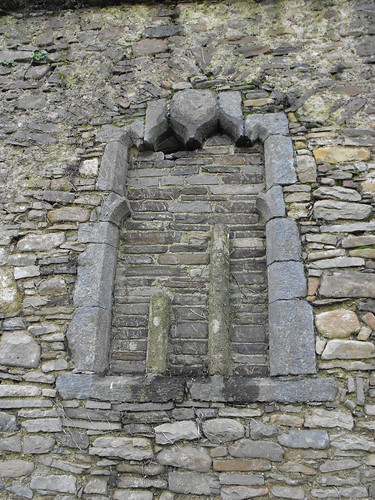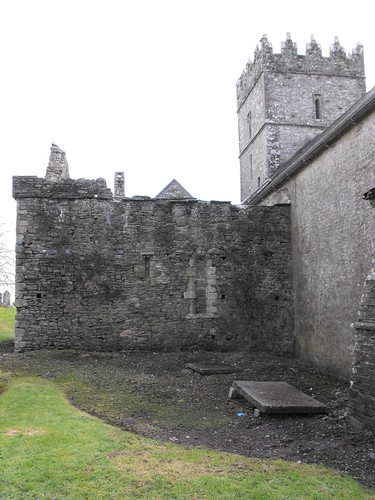Members of St. Conleth's Catholic Heritage Association made a retreat in
Mount Melleray Abbey again this year. The theme chosen for the retreat was
Lectio Divina, to take account of the fact that the Cistercian Abbey where the retreat was being held follows the Rule of St. Benedict (Chapter 48), which gives Lectio Divina an important place in its rule of life, along with Liturgical Prayer and manual labour. Mount Melleray Abbey is situated in the lea of the Knockmealdown Mountains, just to the north of Cappoquin, Co. Waterford. It has been the home of monks of the Strict Observance of the Cistercian Order, known as Trappists, since 1832. The foundation stone of the Monastery was laid on St. Bernard's Day, 20th August, 1833.

"First the tower, austere and massive, gleaming white against the sun,
With its crown of brazen crosses all aflame,
Rose above the circling pine-woods; then the gables, one by one,
To the field of my delighted vision came."
"Now the whole monastic city lay unshrouded to my view,
As a picture on a screen in spendour thrown,
Every snowy arch and angle pointing upward to the blue,
An ecstatic Benedicite in stone."
"Earth's cocoon of light and air,
Wondering Angels peering through,
Find reflections here and there,
Of their home beyond the Blue."

The Abbey Church is in Gothic style and cruciform in plan. Although extended, it follows mainly the lines of the original chapel built by the first community of Cistercian monks. The foundation stone for the new Church was laid by his Eminence John Cardinal McRory on the occasion of the centenary celebration. The Public Church and Monastic Church are the main elements of the magnificent Church-building project undertaken under Dom Celsus O'Connell, O.C.S.O., seventh Lord Abbot of Mount Melleray. The foundation stones were laid on 17th April, 1933, only twelve days after Dom Celsus was elected at Lord Abbot and a few months before the Abbey celebrated its centenary. The Monastic Church, the Church where the monks of Mount Melleray Abbey celebrate the Divine Office every day, was completed and solemnly blessed in November, 1940, but it wasn't until August of 1952, the 120th Anniversary of Mount Melleray, that the Church was solemnly consecrated. Prominent in the monastic Church, as is the custom in all Cistercian churches, was a massive crucifix suspended over the nave and containing relics of St. Bernard and many Irish saints, now, unhappily, removed. The smaller suspended crucifix in the Public Church remains.
The east window seen below is the work of the Harry Clarke studio. The central panel represents Christ the King crowning Our Lady Assumed into Heaven. Each evening at the Office of Compline the lights of the Church are extinguished and, according to Cistercian tradition, the figure of Our Lady is illuminated for the singing of the Salve Regina. To the right of the central panel are St. Catherine of Alexandria and St. Carthage of Lismore, patron of the Diocese of Waterford and Lismore, where Mount Melleray is found, and to the far right are St. Robert, one of the three founders of the Cistercian Order, and St. Patrick of Ireland. To the left of the central panel are St. Brigid of Kildare and St. Columba and to the far left are St. Bernard of Clairvaux, Doctor of the Church and the father of Cistercian monasticism, and St. Malachy of Armagh, who invited St. Bernard to send Cistercian monks to make their first foundation in Ireland.

"...that marvellous melody in whose haunting cadence all the immortal aspirations and emotions of humanity seem to struggle for expression..."
The Consecration of the Monastic Church was carried out by the Ordinary of the Diocese, Bishop Coholan of Waterford and Lismore beginning at 8 a.m. on 20th. The Public Church was consecrated contemporaneously, with Dom Benignus Hickey, O.C.S.O., Abbot of New Mellifont, consecrating the High Altar. During the consecration festival from 20th August to 29th August, 1952, well over 100,000 people visited Mount Melleray, an echo, surely, of the great occasion that was the consecration of the first Cistercian Church in Ireland, at Mellifont in Co. Louth. Mellifont Abbey was founded in 1142, with St. Christian Ó Connarchy as first Abbot. The consecration of the Church, the largest in Ireland at the time, was attended in state by the High King, Murtach Ó Loughlin, together with the flower of the nobility, including MacMurrough, as yet "guiltless of his country's blood." St. Christian, by this time Bishop of Lismore and Papal Legate, presided at the consecration, another direct link, through the Diocese of Waterford and Lismore, to the Abbey at Mount Melleray. Gelasius, Archbishop of Armagh, was principal consecrator, assisted by 17 Bishops.

At Mount Melleray in 1952, the Abbot General of the Cistercians of the Strict Observance, Dom Gabriel Sortais, was liturgically received on the morning of 20th August and His Excellency, the President of Ireland, Séan T. Ó Ceallaigh and Mrs. Ó Ceallaigh were given a liturgical reception that evening. From noon on Thursday, 21st, until Friday, 29th, the law of enclosure was suspended to permit ladies to enter the precincts of the Monastery. On 21st August, the Apostolic Nuncio to Ireland, Archbishop O'Hara, sang Pontifical Mass. On Sunday, 24th, Dom Celsus O'Connell, Lord Abbot of Mount Melleray celebrated Pontifical High Mass in the open air next to the Public Church. On the final day of the festival, Pontifical Vespers in the open air were followed by Benediction and a procession of the Blessed Sacrament through the grounds of the Monastery and was brought back to the High Altar of the Monastic Church for the Office of Compline. The conclusion of the festival was the turning of the key in the lock of the enclosure by the Lord Abbot.

During the course of the retreat conferences, Father McCarthy said that all Catholics should take the words of Pope Benedict XVI seriously when he said: "I would like in particular to recall and recommend the ancient tradition of Lectio divina: the diligent reading of Sacred Scripture accompanied by prayer brings about that intimate dialogue in which the person reading hears God who is speaking, and in praying, responds to him with trusting openness of heart. If it is effectively promoted, this practice will bring to the Church - I am convinced of it - a new spiritual springtime." He said that the starting point for any Lectio divina was the Divinity of Christ. He added that the aim was not to obtain some kind of personal magisterium on the meaning of S. Scripture but rather to converse with God.


Fr. McCarthy introduced the retreatants to the words of Guigo II, the twelfth-century prior of Grande Chartreuse, and spoke about the four elements of Lectio divina: Lectio, to read the Scriptures; Meditatio, to meditate upon them and to settle upon some element that strikes one particularly; Oratio, to pray, the intimate dialogue of which the Pope speaks; and Contemplatio, to contemplate upon all the elements.

Each day was begun with Mass in the Gregorian Rite and concluded with devotions and Benediction of the Blessed Sacrament in the traditional manner. The retreat began on the feast of the Annunciation, carried on through the feast of the Seven Sorrows of Our Lady, and concluded on the Saturday of Passion Week.


The
Abbey Guest House accommodated the retreatants throughout and gave direct access to the Public Church, dedicated to the Assumption of Our Lady and Saint Philomena. It was once the National Shrine to Saint Philomena, although her statue was removed when her name was removed from the Roman Calendar. The Guest House formed part of the older monastery complex.


The interior of the Public Church has five bays consisting of aisles on either side and double lancets above. The Sanctuary is decorated in mosaic, both in nave and aisles. The walls surrounding the side aisles being decorated with adoring Angels. The walls of the Sanctuary having the instruments of the Passion in quatrefoils on the lateral walls, the east wall having the Sacred Heart represented to the Gospel side of the east window and St. Joseph to the Epistle side, each having the appropriate monogram in the quatrefoil beneath.


Perhaps one of the most interesting of all sights in Mount Melleray is the Miraculous Bin which is kept in the farm-yard near the Monastery garden. A long wooden structure about 3 metres long by 1 1/2 metres wide by 1 metre deep, it is regarded the greatest wonder of Mount Melleray. On the cover of the bin is a small notice which tells the story as follows: "DURING THE FAMINE OF 1840, THE COMMUNITY AND MORE THAN SEVENTY POOR PEOPLE WERE FED DAILY WITH MEAL STORED IN THE BIN. AFTER THREE MONTHS THE SUPPLY WAS FOUND UNDIMINISHED." The story is one well known to visitors to Mount Melleray. The then Lord Abbot, Dom Vincent Ryan, left instructions that nobody was to be turned away from the monastery hungry during his absence, which was to last three months, beginning just after Easter. The stock of Indian meal in the bin was found to be undiminished upon his return, although the daily measure required for 100 monks and the more than 70 poor people was taken from it each day. Dom Vincent's written and signed statement attesting to the incident is still extant: "Who will not here admire and praise the wonderful dispensation of Divine Providence. A poor and numerous community of religious men, located on the side of a barren mountain, improvided with funds, resources, or human means necessary to support existence, labouring incessantly in the arduous and painful enterprise of reclaiming its stubborn and neglected soil, depending on the casual charity of humane friends, are thus enabled, I will presume to say miraculously, not only to maintain their own existence, but to feed and preserve the lives of nearly five thousand of their fellow creatures during a period of no ordinary calamity and distress!"

The east window of the Public Church is in two levels, above, in the central panel is Our Lady assumed into Heaven flanked by Angels, while below are, from left to right, St. Brigid, St. Malachy of Armagh (who introduced the Cistercian Order to Ireland), St. Bernard of Clairvaux, friend of St. Malachy, greeting him, and St. Patrick. This is a window of old associations. Mention of St. Malachy and St. Bernard draws the mind back to Mellifont and the first Irish foundation of the Cistercians. The seven main panels of this window were originally in the east window of the old Monastic Church.


To the East of the Monastic Church is 'God's Acre,' the monks' grave-yard, where generations of Cistercians lie. The three High Crosses in the foreground (and another two in the distance) mark the graves of the Lords Abbot of Mount Melleray.

"To my ears as thus I pondered came the sweet and soothing sounds,
Of the Abbey chime, from workshop and from cell,
From the field and from the forest, from the grange's distant bounds,
Calling all to choir, for that's the Office Bell."
If you would like to explore a monastic vocation in Mount Melleray Abbey, the
Novice Master of Mount Melleray Abbey can be contacted by letter at:
Revd. Novice Master, O.C.S.O.,
Mount Melleray Abbey,
Cappoquin,
Co. Waterford,
Ireland.
Or by 'phone at:
+353 58 54404
Or by e-mail by clicking
here.


































![Reblog this post [with Zemanta]](http://img.zemanta.com/reblog_e.png?x-id=9b636602-056e-4b60-9282-f1a183bbfc87)

